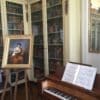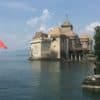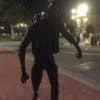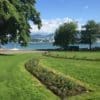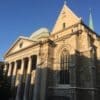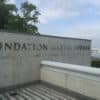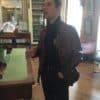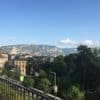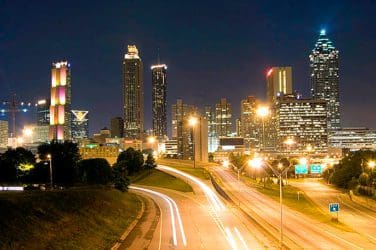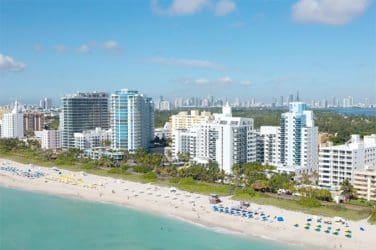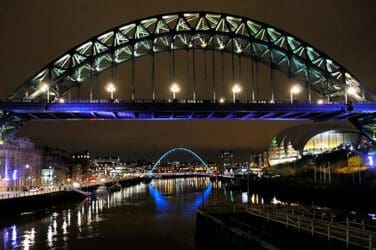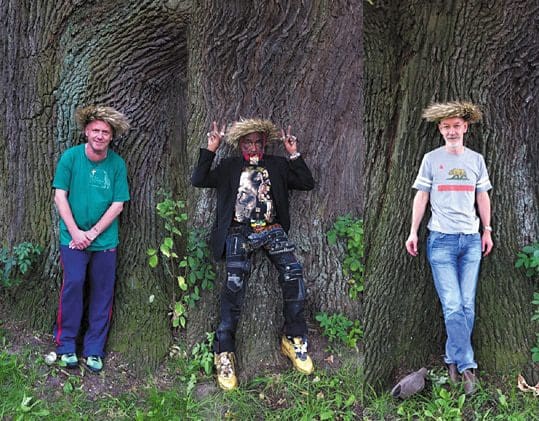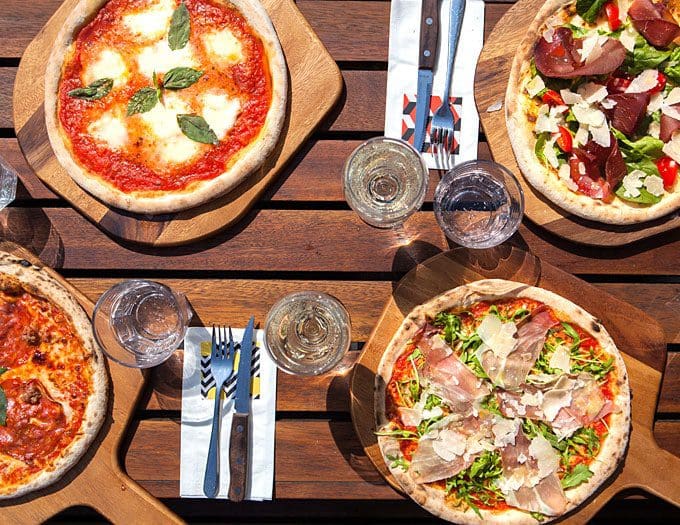Words: Chris Zacharia
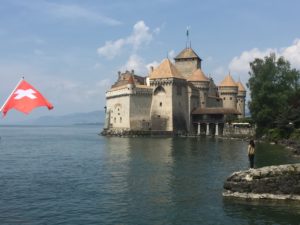
It’s almost midnight in Geneva. The last streetcars are gliding away to the suburbs; the parks lie dark and empty.
But on the edge of Plainpalais plaza, frozen in mid-lunge, stands a monster. Torches on, we approach, shining a light to his face: Frankenstein’s monster, Geneva’s hidden secret.
This year marks the 200th anniversary of Mary Shelley’s Frankenstein. As well as being a remarkable novel, it’s also a book with an unbelievable backstory, one influenced by scandal, suicide, and an apocalyptic volcanic winter.
And yet, although this universally loved novel was conceived here in Geneva, the city itself isn’t aware. I’m here to find out why.
‘Most people don’t even know that this statue exists’ explains our guide Cyrille. ‘For some reason, we Genevans are much less interested in Frankenstein than everyone else’.
Frankenstein’s backstory is well known. In 1816, a band of British writers arrived at the Villa Diodati, a luxurious lakeside estate. There was Mary Shelley, daughter of radical liberal William Godwin and his philosopher wife Mary Wollstonecraft. There was her partner, Percy Shelley, the infamous Romantic poet who had abandoned his wife Harriet to abscond with the then-16 year old Mary.
And then there was Lord Byron, a 19th century Mick Jagger: a man accused of incest, adultery, and genius. Completing the set were Claire Clairemont, Mary’s half-sister who was pregnant with Byron’s child, and John Polidori, Byron’s dashing personal physician with literary ambitions of his own.
Even with such an extraordinary cast of characters, what followed was almost unbelievable.
Here on the shores of Lake Geneva (or as the Swiss call it, Lac Leman) it’s easy to see why a group of young Romantics would have chosen to spend a summer there. This vast, freshwater lake is of such a clear blue that it resembles a second sky lying along the land. Steep forested slopes surround the shores. Impressive villas emerge from the hillsides like flowers in bloom.
Although most Genevans don’t think about Frankenstein, David Spurr does. He’s a professor here at the Bodmer Institute, a beautifully preserved library and museum minutes from the infamous Villa Diodati. So why did these young English romantics travel to Geneva?
‘In 1816, Europe was a very different place’ says Spurr, seated beneath the Bodmer’s countless bookshelves. ‘Until Napoleon was defeated in 1815, British citizens were basically banished from the continent. So for Byron and the Shelleys, visiting Geneva would have been a dream come true’.
But the dream didn’t match the fantasy. On the other side of the world, an Indonesian volcano called Tambora had erupted in 1815 – the largest eruption since the Romans. What followed in 1816 was one of the darkest, gloomiest years in history, which would become known as the ‘Year Without a Summer’. Was it a coincidence that Frankenstein was written in such a foreboding climate?
With the weather so dreadful, the group found themselves stuck indoors, staring out at the gloomy lake. This led to debates, discussions – and stories.
Lord Byron proposed a competition to write the best ghost story. Byron’s tale was adapted by his physician Polidori into the first published vampire story. Percy Shelley’s effort is largely forgotten.
And Mary Shelley – quiet, eighteen year old Mary – wrote what would become one of the most infamous horror stories of all time, and perhaps even the world’s first science fiction.
‘There is no question that the concept of Frankenstein was entirely Mary’s’ Spurr tells us. ‘Although Percy edited and improved her writing, her achievement is nonetheless remarkable’
Stepping out of the Bodmer Institute into the morning sunshine, we follow Spurr down the road toward the Villa Diodati. Now owned by Alan Parker, a communications tycoon, the Villa is not open to the public. We peer over a hedgerow, gazing at the Villa’s marvelous facade of yellowstone and green shutters.
‘It gave them privacy, but Lord Byron was so notorious that word spread about his arrival’ Spur explains in the sunshine. ‘He ended up paying calls to the area’s notable families’
We decide to pursue Byron around the shoreline. Taking the train, we head to Chateau Coppet, an impressive leisure castle facing the lake. Byron visited the Chateau Coppet after being invited by the infamous Madame de Stael, whose witty novels and epigrams were known across Europe.
Inside, the halls and dormitories are kept as they were in its 19th-century heyday. There are original paintings, manuscripts, a fully-stocked library, and even some original 18th century dresses on display. We’re guided around Chateau Coppet by Oliver Lafrance, a comically morose actor who, in 2016, directed a new production of Frankenstein here in Geneva.
‘Frankenstein is Geneva’s dirty secret’ he says, eyes brooding beneath black hair. ‘The people here don’t want to accept this dark story, but it’s very relevant to them’.
How so, I ask?
‘Look at the lake’ Oliver suggests, gesturing at the water from the first floor window. ‘On the surface, it is beautiful: charming, peaceful, welcoming. But down below’ he continues, face blackening, ‘it goes very deep, very dark, where the light cannot penetrate. The catfish, a monstrously large fish, lurks down there. Beautiful surface, dark interior. For me, there are parallels with Geneva itself’
After handing us his promotional Frankenstein t-shirt from his 2016 play (‘You’re journalists, so you need bribes’) Oliver waves us goodbye, advising us to visit the Chateau Chillon, a fortress built atop the lake by the Dukes of Savoy.
But even Frankenstein detectives have to eat. Luckily, the novel has left so many traces that we can have dinner in a hotel visited by Lord Byron and his retinue. Having taken the train around the lake to Lausanne, we walk down to the shores at dusk, just in time to see the shifting, dying blues melting in the water in front of the Hotel Angleterre.
The historic Hotel Angleterre occupies a plum spot by the waterfront. A profusion of white stone, the hotel is stunning – but it’s acknowledged to have been less luxurious back in Byron’s day. During his stay, the poet began writing his acclaimed poem The Prisoner of Chillon, completed at the fortress further around the shore in the Chillon itself.
‘We’re finding more and more guests are asking about Byron’ says Sophie, guiding us through the hotels corridors. What about the Genevans, I ask?
‘Not so much’ she admits.
Amidst the restoration, the hotel has retained a patch of wall as it was when Byron visited. But no one is sure in which room he stayed. Either way, Byron would’ve had a view of the lake, cold and dark as it was in that terrible summer of 1816.
Fortunately, the lake has more than just monsters inside. Just a few feet from the shore, we taste Hotel Angleterre’s fish and seafood, some of which are from Lac Leman. We enjoy succulent octopus, red mullet with skin so crispy it crackles audibly when pressed with a fork, and outrageous sea bass. By the time we’re finishing our dessert, a summer night has fallen over the lake.
The following day, we take the ferry across the lake from Lausanne. It’s another beautiful day, spent on the luxurious deck, passing thickets of gabled houses along the shore. Finally, we emerge at Chateau Chillon, a fortress built by the prestigious Dukes of Savoy. Lord Byron and his retinue visited during that terrible summer.
A charming fortress, half upon land and half upon lake, Chateau Chillon is one of the most visited monuments in Switzerland. We’re taken down into the cool depths of the dungeon, where you can hear the waves of the lake lapping beneath you. Treading gingerly on uneven terrain, we’re shown Byron’s signature carved into one of the pillars, signed 1816.
Upstairs, the rooms are vast but not much more comfortable. Chateau Chillon was a summer residence only; the cavernous rooms were simply too cold in the winter.
But you don’t have to follow in the footsteps of Byron or Shelley to see how Geneva shaped Frankenstein. Back in the city, we take the funicular to the summit of the Saleve, an iconic flat-topped mountain which sprawls across the city’s skyline.
In the novel, the Saleve is the monster’s favourite place in the city, a refuge from the abusive society he fears. For us, it’s about the spectacular views of Geneva and the lake. But each to their own.
We dine at The Observatory, a traditional restaurant where you can feast on delicious fish and seafood as well as the views. As we finish our lunch, I find myself entranced by the sight of the lake below. I’m in agreement with Frankenstein’s monster: this is my favourite place in Geneva.
‘Geneva is a city always in transition’ says Sarah, a local I chat to on the terrace. ‘Many people move here for work, but when their project finishes they move on. Maybe that’s why the Frankenstein legend is so little-known’
As I gaze down at the beautiful city-in-miniature hugging the glassy lake, I feel captivated. Geneva might not know Frankenstein, but it has a legend all of its own.
Start your journey to Geneva with GenevaLive, the city’s tourist board


